Your coronavirus emergency kit: Five workouts to do at home

Editor’s note: This story is being updated regularly.
Countries around the world are closing borders and putting citizens under lockdown in a bid to contain the new coronavirus outbreak, labelled a pandemic by the World Health Organization (WHO).
As more of us are told to stay at home and concerns rise for our safety and the safety of our loved ones, it becomes more important than ever to have the right information.
Here is what you need to know.
My gym is closed: What can I do?
If you live in one of the 170 or so countries affected by the novel coronavirus, it is safe to assume that your local gym or fitness studio has shut its doors.
But that should not stop you from continuing with your routine – or starting fresh – and exercising your mind and body.
Instructors worldwide have asked that people put aside their usual concern with restricted space to readjust and make the most out of their living rooms. Here are five home workouts to do under a lockdown.
Jumping jacks
Jumping jacks are a great way to warm up before you get into serious business. Spread your legs and shoulders apart as you jump.
They are relatively safe although you might want to keep a safe distance between you and others.
Pushups
This one is a no-brainer but you still have to make sure your posture is correct to reap the most benefits and avoid injury.
And for that, your shoulders, spine and hips should all align. You can do as many repetitions as you like – and if that is not challenging enough, extend your hands a little further every time to hit different muscle groups.
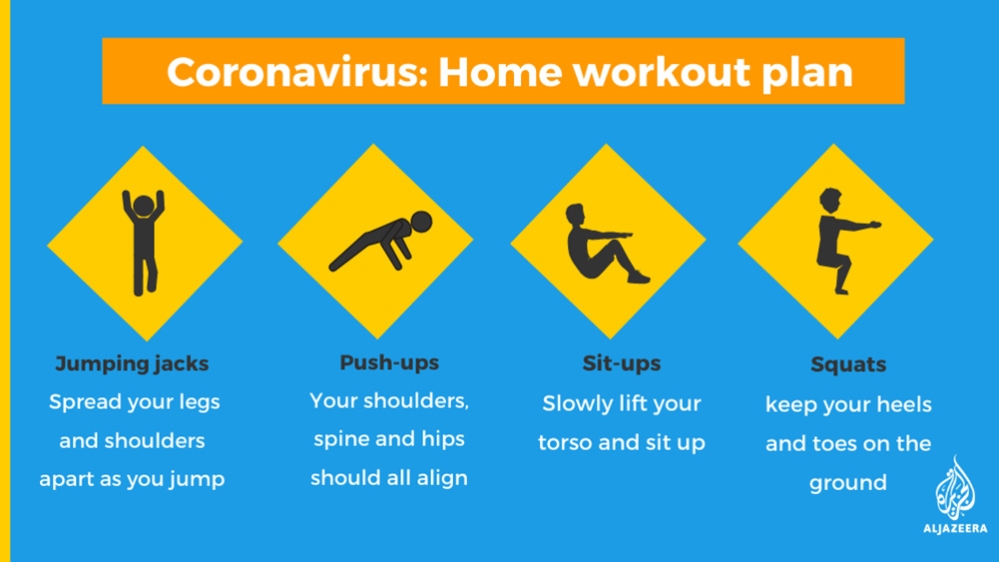
Sit-ups
Doing sit-ups is a great way to strengthen your core. Performing a proper sit-up is as easy as lying on your back, crossing your hands and placing them behind your back, bending your knees and moving your chin towards your knees.
Bodyweight squats
Also known as weightless squats, this all-around exercise helps you strengthen just about everything that is below your belt.
Just place your hands behind your neck, align your shoulders and knees with your feet slightly turned outwards and slowly go down. You can use a chair if you find the movement challenging.
Single leg jumps
Why should you do a single leg jump as opposed to two? Well, jumping on a single leg helps event out or correct any muscle imbalance.
It also helps improve reactivity, coordination and acceleration, to name but a few. As its name may suggest, you can do a one-legged jump by placing your knee slightly ahead of your foot and using the opposite side of your body for momentum by slightly tilting back before you begin.
How serious is SARS-Cov-2?
SARS-CoV-2 is the name given the novel coronavirus; the disease it causes is known as COVID-19.
According to the WHO, the new coronavirus so far has an average R0 (contagion metric) between 2 and 2.5, which means an infected person can pass it on to more than two people.
This makes it more contagious than seasonal flu (R0 1.3), H1N1 – which has an R0 between 1.2 and 1.6 – and Ebola with R0 of 1.6 to 2.
But it is less contagious than SARS, which was passed on to up to four people or MERS, which had a transmission rate between 2.5 and 7.2 in some places.
Several variables can decide whether someone will make another person sick, including the way it is transmitted (through the air or in bodily fluids); whether a pathogen is contagious during its incubation period; how long that incubation period lasts; and how many people the average patient has contact with.
How to protect yourself
There are several directives given by health organisations to stay safe. They include:
- Washing your hands frequently and thoroughly with soap;
- Covering your face when you cough or sneeze, either with a tissue that you immediately dispose of, or with your elbow;
- Avoiding touching your eyes, nose and mouth;
- Cleaning surfaces and objects you touch often;
- Avoiding direct contact with live animals in affected areas.
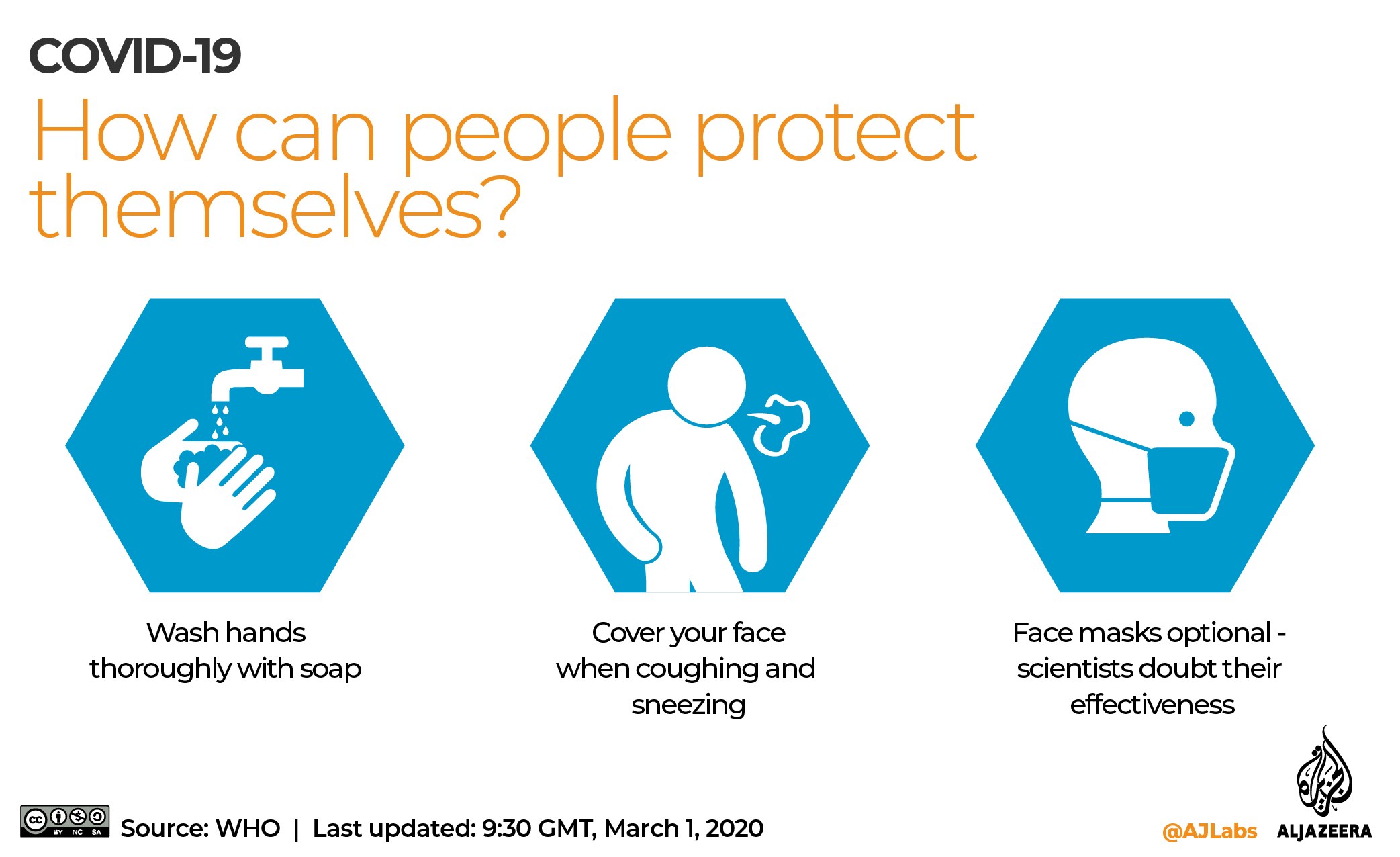
Scientists doubt the effectiveness of face masks in protecting a healthy person from airborne viruses, saying they are more useful in keeping an infected person from affecting others.
More countries are advising people to self-quarantine for at least two weeks while implementing a series of sweeping “social distancing” measures, including banning public gatherings and shutting down schools.
Social distancing aims to slow the spread of the virus, giving global health systems more time to care for patients who need help, which is also known as “flattening the curve”.
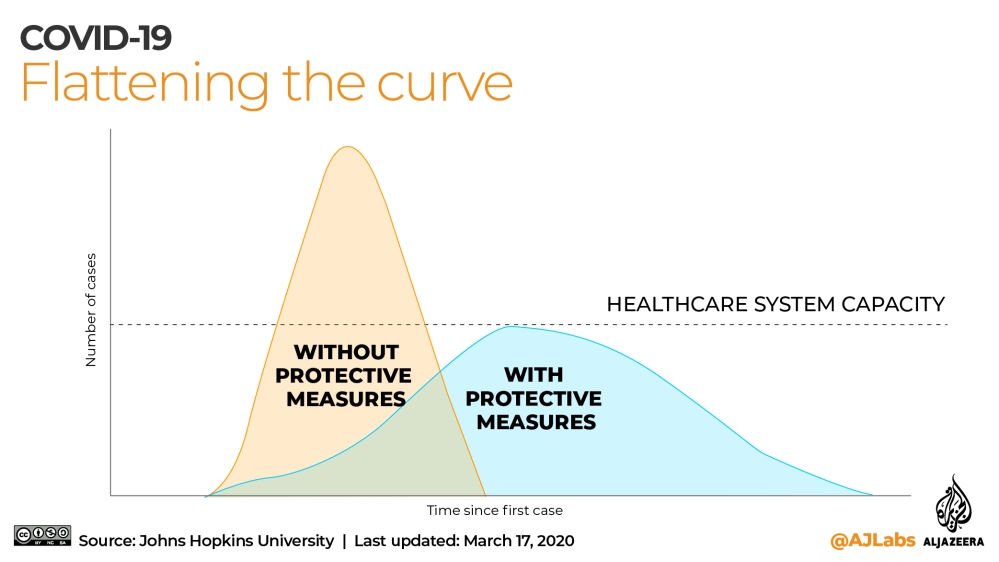
It is most effective when used against infections that can be transmitted via droplet contact (coughing or sneezing), which is the case with the coronavirus.
Cancellation of public events that draw large crowds, such as sporting events and music festivals, is an essential part of social distancing, but avoiding smaller gatherings is equally important, according to Johns Hopkins University.
When you are in any kind of gathering or at a service provider, it is important to stay at least 1.8 metres (six feet) away from anyone around you.
Other social distancing techniques are working from home instead of at the office, e-learning instead of going to school, and visiting loved ones via electronic devices instead of in person.
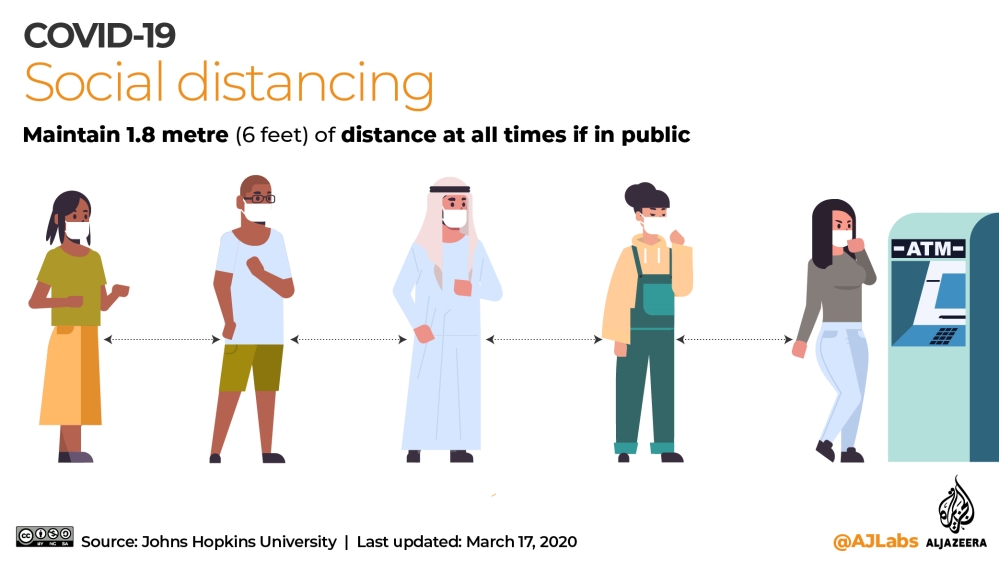
Symptoms and what to do if you think you caught it
According to the WHO, the most common symptoms of COVID-19 are fever, fatigue and a dry cough. Some patients may experience aches and pains, nasal congestion, a runny nose, sore throat or diarrhoea.
Current estimates of the incubation period – the amount of time between infection and the onset of symptoms – range from one to 14 days. Most infected people show symptoms within five to six days.
However, infected patients can also be asymptomatic, not displaying symptoms despite having the virus in their system.
The elderly, those with underlying medical conditions – such as high blood pressure, heart problems or diabetes – and those who are immunocompromised, are more likely to develop serious illness.
Read more on what the coronavirus does to your body if you catch it.

Many countries have set up dedicated hotlines for people who suspect they have been infected.
People are asked to contact the hotline before going to a hospital to avoid the possibility of spreading the virus in an unprepared healthcare facility or on the way there.
Contact specialised help as soon as you suspect you are ill and limit contact with others as much as possible.
To date, there is no vaccine and no medicine for COVID-19. While some traditional or home remedies can provide comfort and alleviate symptoms of the disease, there is no proof that existing medicine can prevent or cure it, according to the WHO.
How to prepare for self-quarantine or lockdown
At least 14 days are recommended for a self-quarantine, while the duration of a lockdown depends on the decision of a local government.
Given the likelihood that more people around the world will be house-bound, preparing one’s home for that eventuality is an increasing concern.
Among the things being stocked are:
Non-perishable foods including shelf-stable beverages, sauces, pasta, pulses, rice, cereal and crackers, and dry goods including tea, sugar, and coffee.
Basic medical supplies including over-the-counter medications to alleviate possible symptoms – which, in mild cases, have a lot in common with the symptoms of the common cold. Medicines for fever, congestion, and cough are recommended. It is also important to keep a one-month supply of prescription medication on hand in case getting to a pharmacy for a refill becomes difficult.
Cleaning and hygiene supplies needed would include soaps for handwashing, bathing, laundry and cleaning, as well as disinfectants to keep surfaces clean.
Also important is preparing some activities that can be undertaken within the home, whether a list of books to read or an entertainment or exercise subscription that can be used without going out.
The WHO has acknowledged the crisis can cause increased levels of anxiety and advised recently that people who are feeling stressed avoid reading, watching and listening to news excessively.
Over-the-counter medications were a subject of debate when France’s Health Minister Olivier Veran tweeted on March 14 that paracetamol was a better remedy to relieve symptoms of coronavirus than anti-inflammatory drugs like ibuprofen, which could worsen the virus.
“The taking of anti-inflammatories [ibuprofen, cortisone] could be a factor in aggravating the infection. In case of fever, take paracetamol. If you are already taking anti-inflammatory drugs, ask your doctor’s advice,” said Veran.
On March 19, the WHO said on Twitter that it did not “recommend against the use of ibuprofen”.
Paracetamol is also known in the US by the generic name acetaminophen.
Myths and misinformation
There is a lot of information and misinformation circulating about the coronavirus. Here and here, we clear up some of the rumours and misconceptions around the outbreak.
Below are some of the myths that may have made you panic, but are not supported by scientific evidence:
No proof hot weather can stop coronavirus
A report by researchers at MIT raised hopes that hotter weather can suppress the coronavirus. But a dramatic surge in infections in Southeast Asia in recent days has increased doubts about the theory, health experts say.
Mosquito bites
There is no evidence showing COVID-19 can be transmitted by mosquitoes, according to the WHO.
Spraying yourself with alcohol or chlorine
Spraying alcohol or chlorine all over your body because you think you were infected will not kill the coronavirus. Alcohol or a chlorine solution can be used to disinfect surfaces, and hand-sanitisers do have a relatively high percentage of alcohol, but the use of these substances has to be according to safety recommendations.
Snow and cold weather
There is no evidence to show that cold weather can kill the new coronavirus. In fact, there is no evidence showing that hot weather can do that, either.
Eating garlic
Garlic is a healthy, aromatic food that is touted for its antimicrobial and culinary properties. But there is no evidence that eating garlic has protected people from the coronavirus, according to the WHO.
Drinking water
There is no scientific evidence that supports consuming large volumes of water at short intervals can help individuals flush the virus into their digestive tract.
Taking antibiotics
Antibiotics only work on bacteria, not viruses.
To date, there is no specific medicine recommended to prevent or treat the new coronavirus.
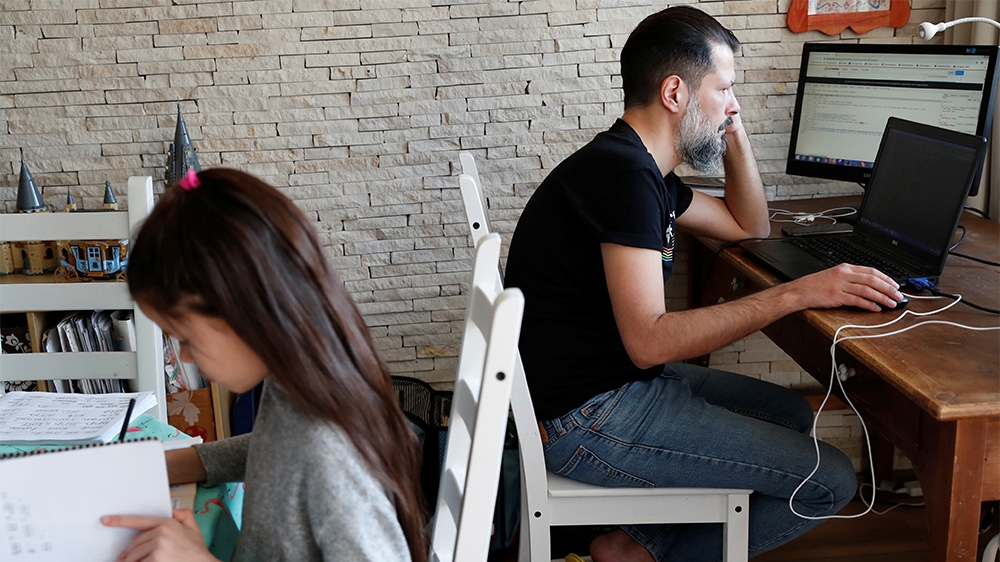
Declutter and organise your working space to keep up your energy and stay focused [Bernadett Szabo/Reuters]
How to work from home effectively
If you are asked to work from home during the pandemic, here are a few tips to help you make the most of the situation.
Declutter and set up a ‘home office’
In order to keep up your energy and stay focused, it is best to declutter and organise your working space.
If you do not have a desk, choose a table that will work instead. Clear the surface and leave only what is essential to your work and one object that makes you happy to look at it.
Try to choose a quiet space, preferably in a room separate from the rest of the family’s activities or from where you sleep and relax.
It is also important to allow natural light into your workspace. It will boost your vitamin D levels and improve mental health and productivity.
Set up your laptop or computer, printer and charging station. Having enough electric outlets is important, so you may need to repurpose an extension cord from another room.
If you need to print or file documents, make sure your filing cabinet is handy or, if you do not have one, that you have some kind of organising system in mind using spare boxes, magazine files or even kitchen trays.
Separate ‘home you’ from ‘work you’
Keep as much of your routine as intact as possible. So, take a shower and get dressed in the morning, avoid staying in your pyjamas while working. Acting as if you are going to the office will help you mentally separate your work hours from your downtime and will keep you motivated and in a better mindset.
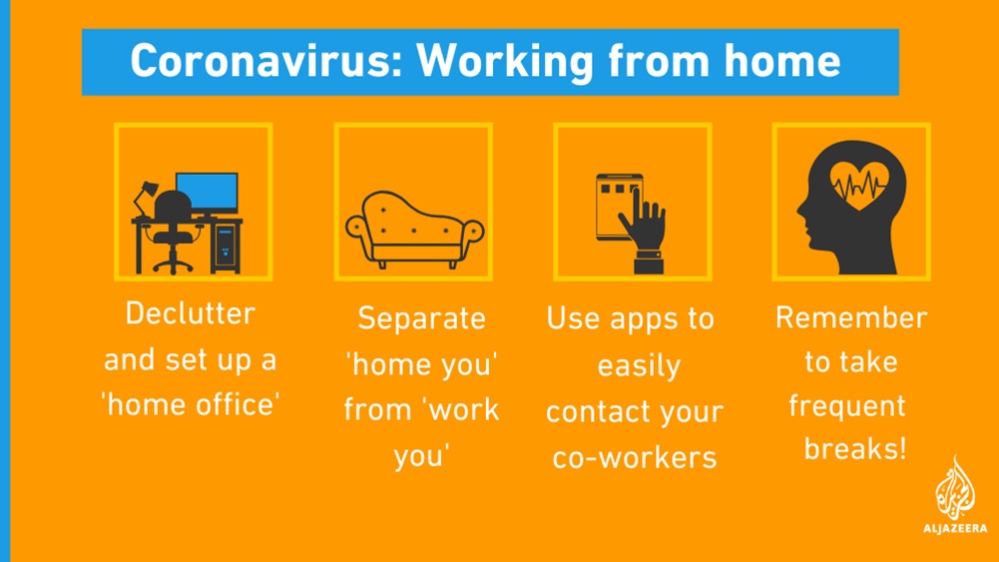
Use apps to make up for distance
There are plenty of apps available that help you to work with your colleagues remotely. Many employers use Slack or Microsoft Teams for messaging.
For videoconferencing, you can use Skype, Zoom, BlueJeans and WebEx, while tools such as Asana and Trello help to manage team collaboration projects.
DropBox, Google Drive and Box help you to share files.
Maintain your physical and mental health
Remember to take breaks to help you recharge and stay focused. If possible, try taking a 15-minute walk outside, with the necessary precautions.
Andreas Kappes, a social psychologist, neuroscientist and lecturer at the University of London, told Al Jazeera that physical activity plays a large part in keeping us happy and productive.
Maintaining simple “mundane interaction” with family also helps contribute to one’s wellbeing, Kappes said.
“You might sometimes feel, ‘Why should I call my mother, just to tell her basically that nothing happened?’
“But you should give yourself the permission to have ordinary, boring conversations with others because they really contribute to our feelings of happiness and being connected to others,” Kappes said.